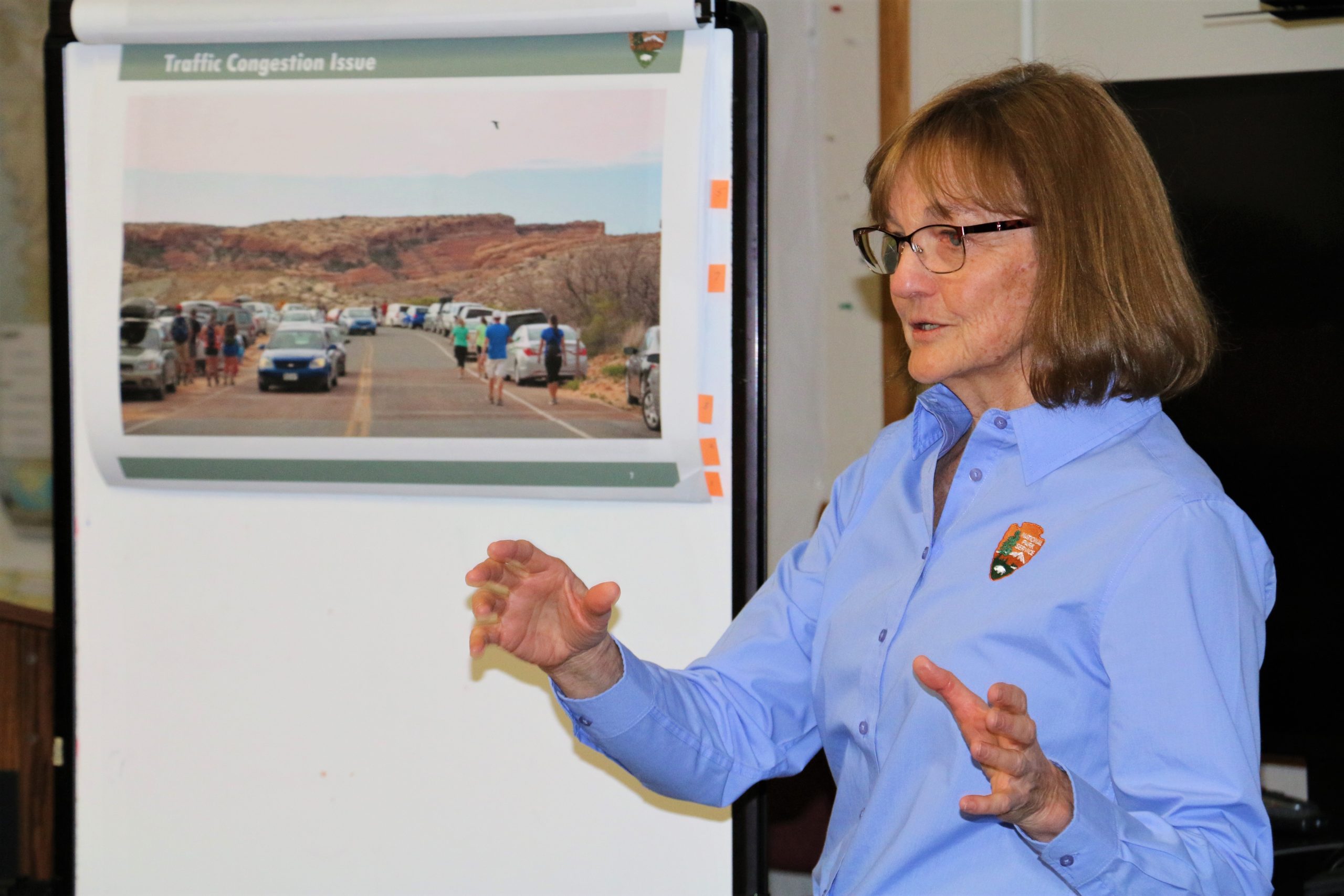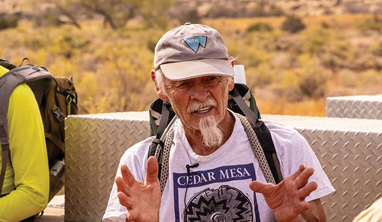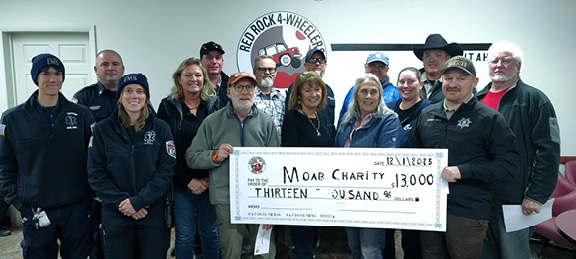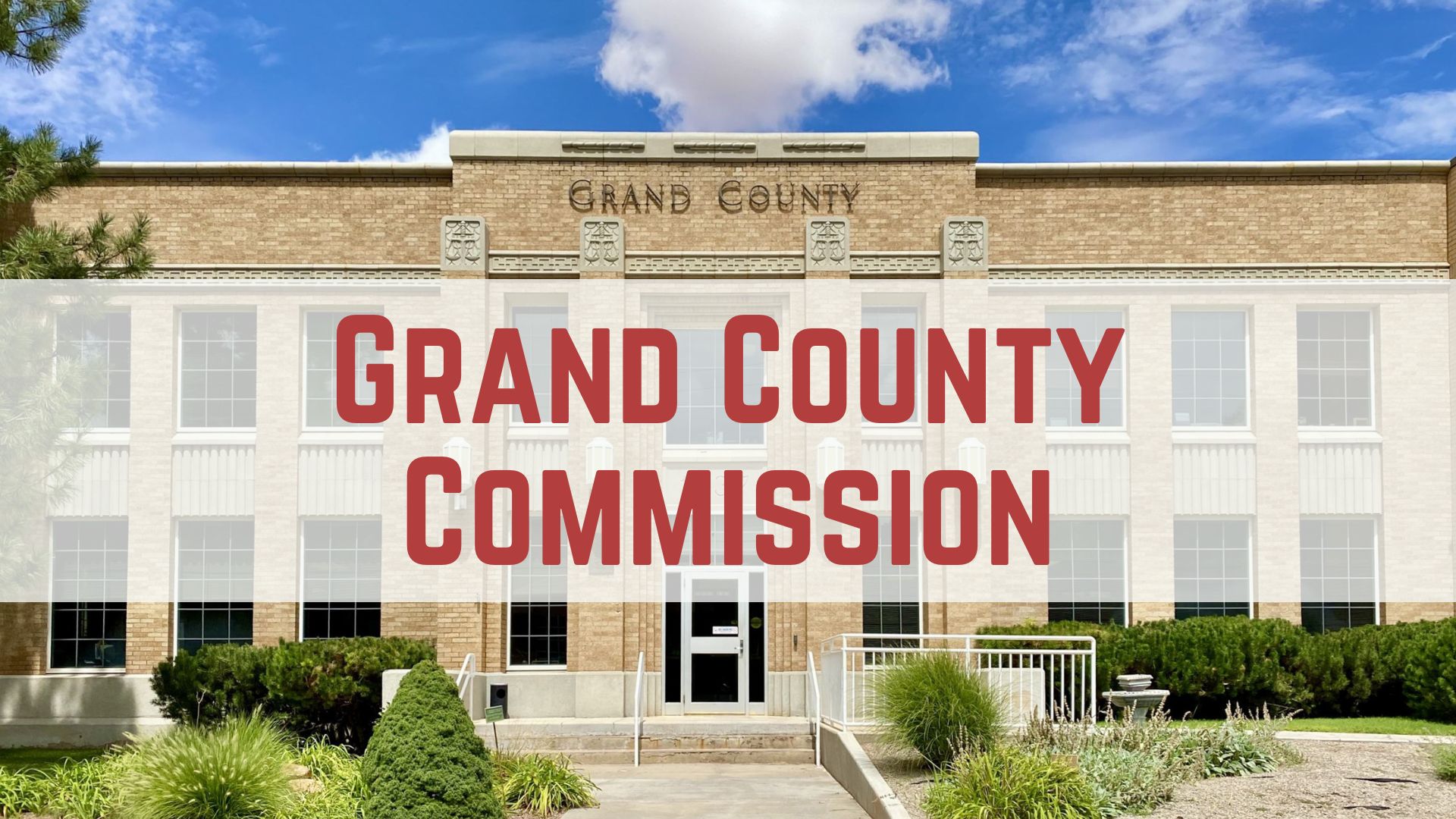Some information may be outdated.
Michael Liss and Kate Cannon can likely agree that Arches National Park is a beautiful place that should be protected over the long term.
But the shared points of view between Liss – a Moab developer – and Cannon – the National Park Service’s Southeast Utah Group superintendent – ended there during their first formal meeting with other local stakeholders.
Disagreements between the two escalated during the Feb. 6 meeting that Liss organized, as Liss told Cannon that she is “not (his) schoolteacher,” and Cannon reprimanded him for “casting aspersions” on herself and other park employees.
Two Grand County Council members and others were there to hear Cannon’s presentation in support of the park’s proposal to adopt a reservation-based entry system during peak visitor periods from March through October. Liss, meanwhile, was there to promote alternatives to the agency’s plan, including a proposal to develop a 2,000-car parking area and visitor facilities on an already remediated portion of the Moab Uranium Mill Tailings Remedial Action (UMTRA) Project site.
Liss – the public face of a group called Arches for the People – began his presentation on an optimistic note, outlining his vision to help park officials manage traffic congestion at Arches in the near future and over the longer term.
“I really think we can do this,” he said. “I hope that at the end of this meeting, we can say, ‘You know what? Let’s just work together, because it would be a lot more fun.’”
Yet by the time he concluded his remarks, Liss was striking a different tone, saying the two sides are at loggerheads, and warning of the effects that a reservation system could have on Moab’s businesses and tourist industry.
“We’re not going to solve this – the issue of the impact on the local economy – here, because we think one thing (and) you think the other,” he said. “So all I recommend is, file your FONSI (Finding of No Significant Impact in support of the reservation system), and we’ll take it from there … We’ll protest it. That’s all we can really do.”
“This is not what we want our visitor experience to be”
If it’s adopted, the reservation-based entry system would take effect no earlier than March 2019.
Cannon said that park officials need to come up quickly with a solution to overcrowding at Arches, in response to visitation trends in recent years.
Part of the credit – or blame – for those trends can go to the Utah Office of Tourism, whose wildly successful “Mighty 5” advertising campaign has increased national and international awareness of Arches and other national parks in the state.
“Now we have all those people coming to a place that they love and they want to enjoy, and they go back and tell their friends, and then their friends all come out,” Cannon said.
Consequently, she said, visitors are now at risk of having to wait in line for 90 minutes during peak visitation periods, and once they get in, they have to “orbit the parking lots” until someone else drives out.
“This is not what we want our visitor experience to be,” she said. “It’s not the great, enchanting kind of visit we want people to have, and it doesn’t have to do with solitude, but it does have to do with being able to travel through the park and go where you want to go.”
The number of visitors to Arches has doubled in the past 11 or so years, reaching about 1.6 million in 2016 – and up significantly from what had been a record 1.25 million during the first 10 months of 2014.
Under the proposal, the agency would set a daily entrance cap of 2,006 vehicles between the hours of 7 a.m. and 6 p.m. – when park visitation is typically at its highest – in order to address the impacts that park officials tie to growing visitor numbers.
A traffic count from June 2016 showed that an average of 444 vehicles entered the park either before or after those times. Cannon has said that hundreds of people could still come and go during those off-hours even if they didn’t make advance reservations.
In addition, the proposal would set aside 25 percent of the reservation slots for the day – or the day after – visitors arrive without reservations.
“So if you drive into Moab and you don’t have a reservation, you could go on … to your (computer) and sign up for one of those 25 percent slots, or you could go to the (Moab Information Center) or the Arches Visitor Center, and an employee will help you,” she said.
Visitors who don’t have reservations could also enter on a limited number of shuttles that businesses would compete to operate, she said; commercial operators would not need reservations to enter the park.
But Liss vowed that Arches “will not” become the first major national park to adopt the reservation system. He estimated that park visitors accounted for 63 percent of tourists who came to Moab in 2016, and voiced concerns about what would happen if those people were discouraged from visiting Arches.
As an alternative, he highlighted his ambitious vision of a solar-powered, zero-emissions national park of the future, where fleets of self-driving electric vehicles and shuttles carry visitors between the UMTRA parking hub and Arches’ attractions.
Russell McCallister, the Moab UMTRA Project’s new federal director, said last month that Liss’ plan for the remediated portion of the site is “doable.” But he added that he thinks there’s “no way” it can be done in that two-year time frame, given what he called the “snail’s pace” of bureaucracy.
Still, Liss wagered that he can meet his two-year deadline.
“I’m now going to get you – and I’m going to do it – a 2,000-car parking lot in two years at the UMTRA site,” Liss said. “It’s not going to take 35 years; it’s not going to take 20 years … You can write it on a piece of paper, and I’ll make you a $10 bet. Seriously – it’s not even funny.”
He later upped his original bet to $100 – and vowed to launch a national technology and design competition to gather innovative ideas, while offering Arches the services of urban planners and traffic engineers.
“I’m going to put wi-fi transponders on your mini-shuttles, and you’re going to get wi-fi all over the park, and that’s how we’re going to enter the park,” he said. “We don’t even need any cars, OK?”
Visitation data become sticking point
The two speakers’ presentations stayed largely on track until Liss said he doesn’t trust the park’s revised data showing that Arches’ visitation numbers for 2017 dropped by 3 percent.
“Where did 70,000 people come from and then disappear?” he asked. “I don’t get it.”
Over Liss’ objections, Cannon noted that the park was closed between February and November 2017 from 7 p.m. to 6 a.m. for road construction work. However, traffic counters included the construction-related traffic during that period, she said, and when park officials noticed those additional figures in an official report, they contacted the agency’s regional office in Denver and asked officials there to remove them.
“We pulled out those numbers,” Cannon said. “That’s why it dropped.”
“There’s nothing devious in this,” she added. “We’re straightforward and honest people.”
Liss countered that the numbers look strange to him, sparking a heated back-and-forth with Cannon.
“I was, like, shocked, when I saw this,” he said.
“Well, I was shocked when I heard you challenging those numbers,” Cannon said, adding that Liss could have asked her for more information.
“No, I actually couldn’t,” Liss said, stating that Cannon wouldn’t allow him to meet with her if he brought a reporter along with him. “I’m not going to meet with someone alone.”
Cannon, in turn, asked Liss why he didn’t come in and ask about the data.
“Because I’m a rebel, and I’m just doing my homework,” he said. “And I didn’t feel that you’d give me other information that would be useful.”
Cannon then scolded Liss for – in her words – “casting aspersions” on herself and her staff.
“We work very hard, and we’re very interested in accuracy – and we’re honest,” she said.
“I hope so,” Liss said. “Because this was totally outrageous to me.”
Others weigh in on reservation plan
Moab Chamber of Commerce Executive Director Lexie Samuelsen said the entire local business community wants everyone to have a quality visitor experience at Arches.
“I think that this (proposal) might not necessarily be the proper approach to solve this issue,” she said. “I think there’s other things that we could explore well in advance before trying something like the reservation system. It seems a little bit (like) jumping the gun.”
According to Samuelsen, many visitors who typically have three days to spend in the area limit themselves to Arches, without considering the possibility of visiting places like Canyonlands National Park or Dead Horse Point State Park.
“None of it’s on their radar,” she said. “They get here and they’re like, ‘Well, we’ve heard something about Canyonlands, but we’re really here for Arches,’ and we kind of have to persuade people to go to Canyonlands.”
Grand County Council vice chair Curtis Wells noted that a large part of the county’s revenue is reliant on Transient Room Taxes on overnight accommodations.
“That’s an important piece of our economy,” Wells said. “I feel like a lot of tourists are here specifically for Arches. It’s a big attraction to people, and so we approached it from the council (from) more of an angle that if this is going to happen, we want to be involved as much as possible, and make sure that (Moab Area Travel Council Executive Director Elaine Gizler’s office) … can help mitigate any problems that would come about to implement the reservation system.”
Gizler said her office has been working with the Utah Office of Tourism and other state officials to identify challenges related to congestion at Arches, and the park’s proposal.
Cannon, she said, has been flexible on some of the initial questions that tourism officials had.
Those officials want to ensure that the solutions that park officials ultimately implement are in the community’s best interests, Gizler said.
“I’ve expressed that to Kate,” she said. “She gets it; she knows it.”
County officials join discussion over proposal to avoid reservation-based entry system
Appreciate the coverage? Help keep local news alive.
Chip in to support the Moab Sun News.





